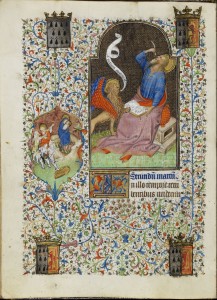Raman spectroscopy is one of the most widespread methods for the scientific analysis of cultural heritage materials, including pigments on paintings and illuminated manuscripts. It can reveal the ‘fingerprint’ of numerous pigments, mainly inorganic, at a microscopic level. Raman spectra are included in some of the hotspots you can explore on this website.
Raman analysis and data processing was carried out by Prof. Andrew Beeby (Dept. of Chemistry, University of Durham) and Dr. Kate Nicholson (Dept. of Applied Sciences, Northumbria University). Raman spectra were recorded using one of two dedicated spectrometer systems optimised for the study of manuscripts. Both systems employ a HeNe laser (632.8 nm) which is focused into a fibre-optic probe for delivery to the sampling head. This is equipped with an ultra-long working distance 40x microscope lens which provides a working distance of c. 10 mm from the surface of the page. The laser power at the sample was measured before each run and was < 0.3 mW, with the laser spot on the sample estimated to be ca. 50 μm diameter. The Raman signal is passed down a second fibre optic to one of two CCD-spectrographs (Ocean Optics or Andor). Spectra were typically the sum of 20x5 seconds acquisitions (Ocean Optics) or 20x1 seconds acquisitions (Andor). A USB microscope was also mounted on the sampling head, allowing an image of the area and the precise position of the laser spot on the page to be recorded. Spectral interpretation was based on a number of published reference databases.



